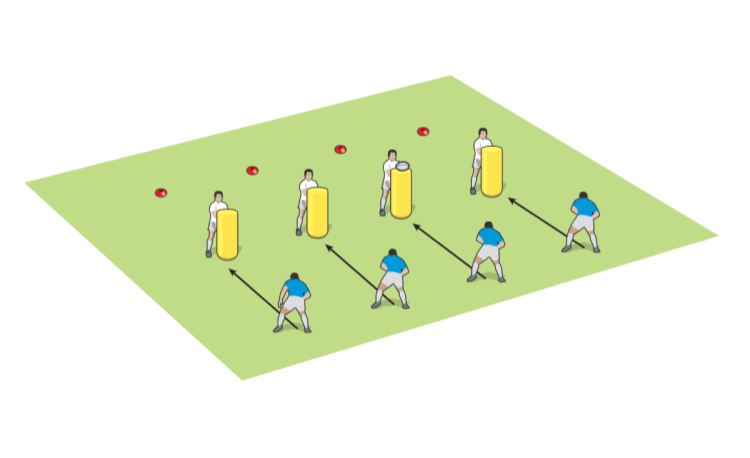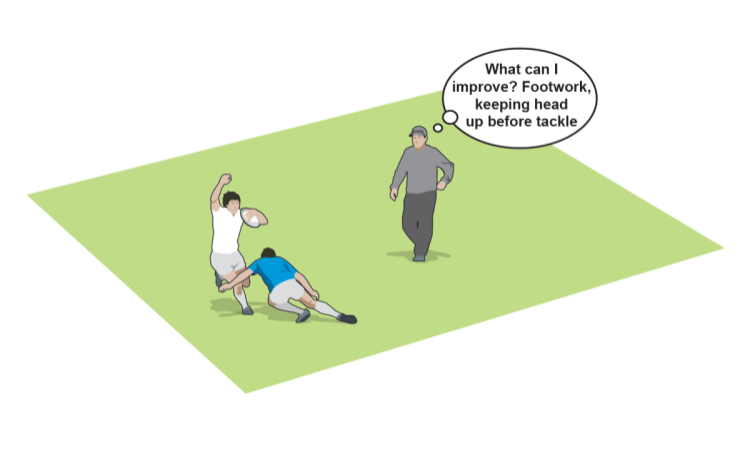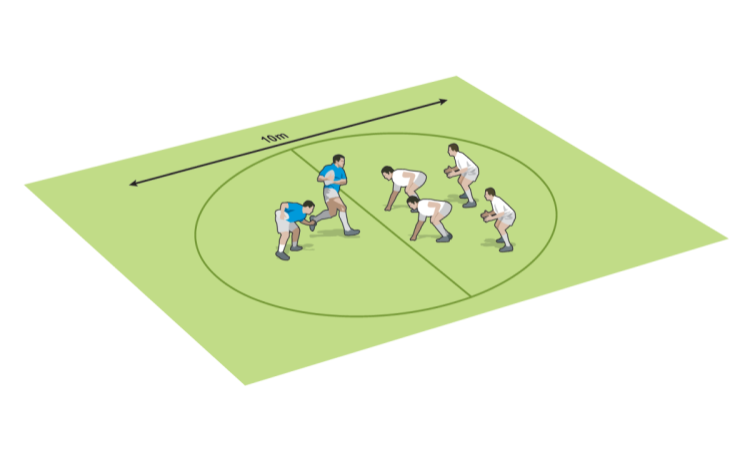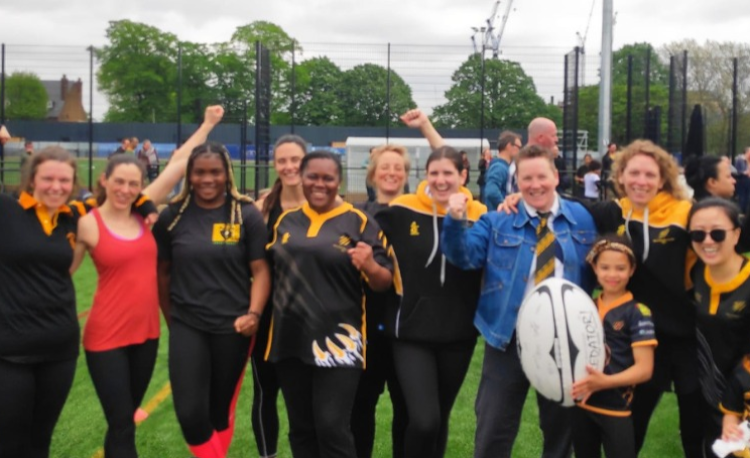You are viewing
1 of your 2 free articles
Tackling and offloading: Multi-focus games-led session for younger players
Defenceby Dan Cottrell
Use this session to develop two core skills for players so they have a chance to practise and nail one key factor for each.

Walking tackling
In a 20m box, play up to 5 v 5 walking rugby. Tackles are only made if the head is on the shorts of the ball carrier.
Turn over the ball after five of these tackles or if the ball carrier runs with the ball.
Tackle exercise
In a small box, put one tackler, and three to four ball carriers. On the whistle, the tackler has to grab and lift each player only 1cm off the ground (and no more).
This promotes a tight grip. Swap roles and let each player have two goes. Feedback halfway through on improvements (like getting close to make the grip).
Back to walking rugby
All tackles now are by tight grip and lift.
Exercise
Back into the small box with one tackler and two ball carriers. Chasing ball carriers and grip and lift. Can they do it in 15 seconds?
Back into the game
Play 5 v 5 in wide but not long box. Grip tackles with a lift. Remember the lift is only a few centimetres.
Offloading game
Change the game to touch rugby. The ball carrier has three seconds to offload ball after a touch. Eventually, the defenders will start to block passes. They are not allowed to grab the player. This means attackers will have to use footwork avoid this. Stop the game after five minutes to feedback on what could happen next.
Exercise
Play 2 v 1 in a narrow corridor. A tackler starts at the side of the box about 5m away from the ball carrier and his support player. The tackler can only grab shorts. The ball carrier tries to beat the defender first, then offloads the ball.
Develop this exercise by starting the support player directly behind the ball carrier.
Offloading game
Back to the game, but grab tackles and grabbing the ball are allowed. Attackers will have to work even harder to keep the ball free.
Spend half an hour maximum on each core skill. Around 20 minutes on the games and 10 minutes on the skills exercise.
Concentrate on two key factors to correct throughout the session. If the players are failing to do other aspects, like communicate, leave them alone.
In addition to adjusting bad habits, look for good habits too. Don’t correct them if you don’t see, but praise them if you do.

TACKLING
Walking tackling
In a 20m box, play up to 5 v 5 walking rugby. Tackles are only made if the head is on the shorts of the ball carrier.
Turn over the ball after five of these tackles or if the ball carrier runs with the ball.
Tackle exercise
In a small box, put one tackler, and three to four ball carriers. On the whistle, the tackler has to grab and lift each player only 1cm off the ground (and no more).
This promotes a tight grip. Swap roles and let each player have two goes. Feedback halfway through on improvements (like getting close to make the grip).
Back to walking rugby
All tackles now are by tight grip and lift.
Exercise
Back into the small box with one tackler and two ball carriers. Chasing ball carriers and grip and lift. Can they do it in 15 seconds?
Back into the game
Play 5 v 5 in wide but not long box. Grip tackles with a lift. Remember the lift is only a few centimetres.
OFFLOADING
Offloading game
Change the game to touch rugby. The ball carrier has three seconds to offload ball after a touch. Eventually, the defenders will start to block passes. They are not allowed to grab the player. This means attackers will have to use footwork avoid this. Stop the game after five minutes to feedback on what could happen next.
Exercise
Play 2 v 1 in a narrow corridor. A tackler starts at the side of the box about 5m away from the ball carrier and his support player. The tackler can only grab shorts. The ball carrier tries to beat the defender first, then offloads the ball.
Develop this exercise by starting the support player directly behind the ball carrier.
Offloading game
Back to the game, but grab tackles and grabbing the ball are allowed. Attackers will have to work even harder to keep the ball free.
TIMINGS
Spend half an hour maximum on each core skill. Around 20 minutes on the games and 10 minutes on the skills exercise.
FAULT CORRECT
Concentrate on two key factors to correct throughout the session. If the players are failing to do other aspects, like communicate, leave them alone.
- Grip – a strong grip in the tackle means the arms are wrapped around the legs of the ball carrier, with the head tight to the body. Sometimes it’s called the ring of steel. Without a strong grip, they won’t be able to lift a player 1cm off the ground, which is a good indicator of success.
- Footwork – this means getting to the edges of the tackler. The ball carrier gets going forward but steps to one side or the other of the ball carrier.
AREAS FOR PRAISE
In addition to adjusting bad habits, look for good habits too. Don’t correct them if you don’t see, but praise them if you do.
- Head position – putting the head in the safest place for a tackle.
- Leg drive – in the tackle or through contact, keeping the legs moving.
- Support lines – coming onto the pass at pace.
Newsletter Sign Up
Coaches Testimonials

Gerald Kearney, Downtown Las Vegas Soccer Club

Paul Butler, Florida, USA

Rick Shields, Springboro, USA

Tony Green, Pierrefonds Titans, Quebec, Canada
Subscribe Today
Be a more effective, more successful rugby coach
In a recent survey 89% of subscribers said Rugby Coach Weekly makes them more confident, 91% said Rugby Coach Weekly makes them a more effective coach and 93% said Rugby Coach Weekly makes them more inspired.
Get Weekly Inspiration
All the latest techniques and approaches
Rugby Coach Weekly offers proven and easy to use rugby drills, coaching sessions, practice plans, small-sided games, warm-ups, training tips and advice.
We've been at the cutting edge of rugby coaching since we launched in 2005, creating resources for the grassroots youth coach, following best practice from around the world and insights from the professional game.
More from us
© 2023 Rugby Coach Weekly
Part of Green Star Media Ltd. Company number: 3008779
We use cookies so we can provide you with the best online experience. By continuing to browse this site you are agreeing to our use of cookies. Click on the banner to find out more.













